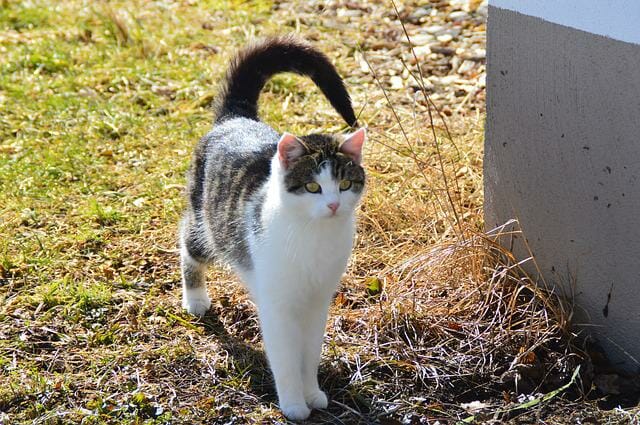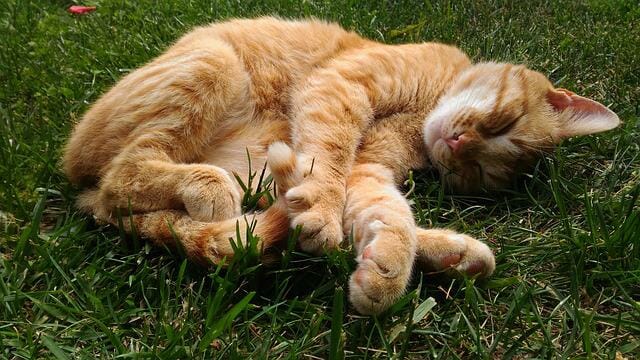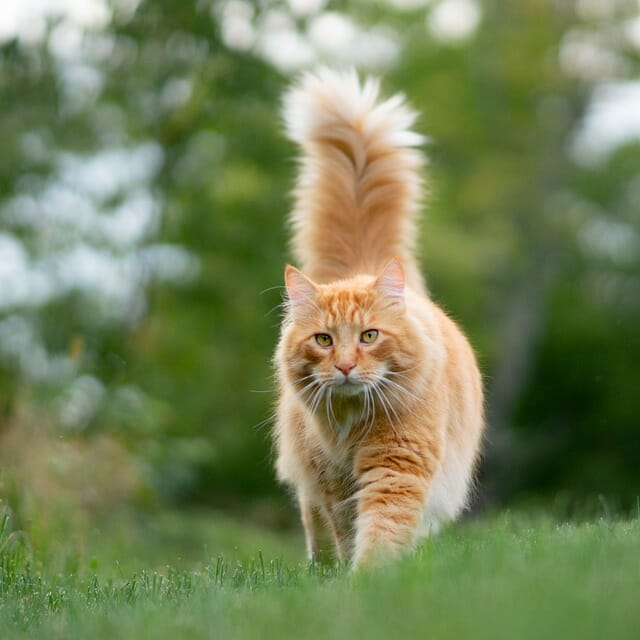When a Cat Wags It’s Tail What Does It Mean: Reasons Why Cats Wag Its Tail and How to Deal With It
When a cat wags its tail rapidly or in an upright position, it can be a sign of aggression. If a cat is also hissing or growling, it’s best to give the cat space and avoid approaching or petting it. This behavior may be a warning that the cat feels threatened or uncomfortable, and it’s important to respect the cat’s boundaries to prevent a potential attack. If the behavior persists or becomes frequent, it may be helpful to seek advice.


Table of Contents
Reasons Why Cats Wag Their Tails
Fear
When a cat wags its tail in a low and slow position, it can signify fear or anxiety. Other accompanying behaviors may include flattened ears, dilated pupils, crouching, or hiding. Creating a calm and safe environment for the cat is important by removing potential stressors, such as loud noises, unfamiliar people, or animals. Give the cat space and allow it to retreat to a quiet and secure location where it feels comfortable.
Irritation
When a cat wags its tail, twitching can indicate irritation or annoyance. This behavior may be accompanied by other signs such as flattened ears, a swishing tail, or growling.
If you notice your cat exhibiting this behavior, it’s important to give them space and avoid any actions that may aggravate them further, such as petting or picking them up. Identify the source of your cat’s irritation and remove it if possible. This may be a particular noise or smell, an unfamiliar person or animal, or even a dirty litter box.
Happy
When a cat wags its tail slowly and in a relaxed position, it can indicate that it is content and relaxed. This type of tail wag is usually accompanied by other signs of relaxation, such as purring, kneading, and a soft body posture. A cat’s ears may also be positioned forward or slightly to the side, indicating that the cat is at ease and not feeling threatened.
It’s important to note that tail wagging is not always a reliable indicator of a cat’s emotional state, and it’s important to consider other behaviors and body language cues when trying to understand how a cat is feeling. Additionally, some cats may not wag their tails when happy, so it’s important to be familiar with your cat’s behaviors and personality.
Excited
When a cat wags its tail in a high position rapidly, it can be a sign of excitement or playfulness. Other accompanying behaviors may include jumping, running, and vocalizing. This behavior is usually harmless and can be fun for cats to interact with their environment or human companions. If you notice your cat exhibiting this behavior, engaging in playtime with them is okay if you know your cat’s body language and behaviors.
Sleepy


When a cat feels sleepy or relaxed, its tail will likely be low, still, or even tucked around its body. The cat’s body will be loose and soft, and its eyes may be closed or partially closed. The cat may be curled up in a ball or stretched out comfortably.
This behavior is normal and healthy for a cat, as cats typically sleep for several hours each day. Therefore, important to provide your cat with a comfortable and safe sleeping environment, such as a cozy bed or a cat tree, to help them feel secure and relaxed while they rest.
Pain
When a cat is experiencing pain, its tail may be held in an unusual or tense position, or it may not move at all. According to the Animal Medical Hospital of Poway, the cat may exhibit other signs of discomfort, such as vocalizing, panting, or licking or biting at the affected area. If you suspect your cat is in pain, seeking veterinary attention as soon as possible is important.
Cats are experts at hiding their pain, and the underlying issue may be quite advanced when they show clear signs of discomfort. For example, a veterinarian can help identify the source of your cat’s pain and provide appropriate treatment, including medication, surgery, or other interventions.
Things to Do When Cats Wag Their Tails
Respect Your Cat’s Space
- Allow your cat to come to you: Cats are independent creatures and often prefer to approach humans on their terms. If your cat seems hesitant or uncomfortable, avoid approaching them and allow them to come to you when they feel comfortable.
- Avoid sudden or loud noises: Sudden movements can startle or scare cats, leading to fear or aggression. Be calm and gentle in your interactions with your cat.
- Provide a safe and comfortable environment: Make sure your cat has access to a comfortable and safe space where they can retreat when they need to rest or feel secure.
- Avoid overcrowding: Avoid overcrowding your cats or invading their personal space. Instead, cats need space and time to feel comfortable and secure.
- Respect your cat’s body language: Pay attention to your cat’s body language and behaviors, such as tail position, ear position, and vocalizations. For example, if your cat exhibits signs of discomfort or aggression, give them space and avoid any actions that may further aggravate them.
Engage in Playtime


- Please choose the right toys: Cats have different play preferences, so choosing toys your cat enjoys is important. Some cats prefer toys that mimic prey, such as mice or birds, while others prefer toys they can bat around or chase. Experiment with different types of toys to find what your cat enjoys.
- Use interactive toys: Interactive toys, such as wands or laser pointers, can help stimulate your cat’s natural hunting instincts and encourage them to engage in physical activity. Supervise your cat when using interactive toys to ensure their safety.
- Set aside dedicated playtime: Set aside dedicated time each day to play with your cat. This can help establish a routine and give your cat the mental and physical stimulation they need.
- Vary the type of play: Varying the type of play can help keep your cat engaged and prevent boredom. Mix up the types of toys you use, the location of playtime, and the duration of play sessions.
- End playtime on a positive note: End playtime on a positive note by giving your cat a treat or some affection. This can help reinforce positive associations with playtime and strengthen your bond with your cat.
